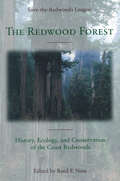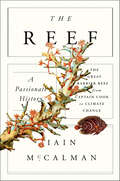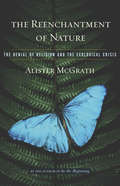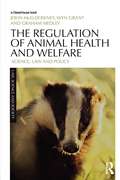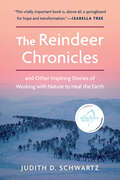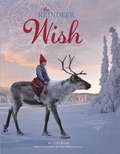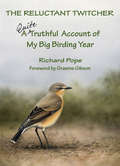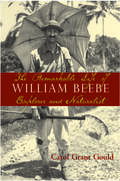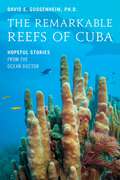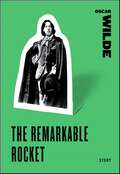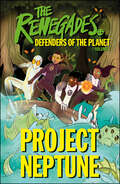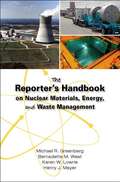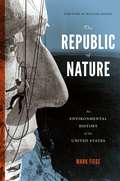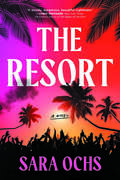- Table View
- List View
The Redwood Forest: History, Ecology, and Conservation of the Coast Redwoods
by Reed F. Noss Save-the-Redwoods LeagueEvidence is mounting that redwood forests, like many other ecosystems, cannot survive as small, isolated fragments in human-altered landscapes. Such fragments lose their diversity over time and, in the case of redwoods, may even lose the ability to grow new, giant trees.The Redwood Forest, written in support of Save-the-Redwood League's master plan, provides scientific guidance for saving the redwood forest by bringing together in a single volume the latest insights from conservation biology along with new information from data-gathering techniques such as GIS and remote sensing. It presents the most current findings on the geologic and cultural history, natural history, ecology, management, and conservation of the flora and fauna of the redwood ecosystem. Leading experts offer a comprehensive account of the redwoods ecosystem, with specific chapters examining the history of the redwood lineage; terrestrial flora and fauna, communities, and ecosystems; aquatic ecosystems; landscape-scale conservation planning; and management alternatives relating to forestry, restoration, and recreation; among other topics.The Redwood Forest offers a case study for ecosystem-level conservation and gives conservation organizations the information, technical tools, and broad perspective they need to evaluate redwood sites and landscapes for conservation. It contains the latest information from groundbreaking research on such topics as redwood canopy communities, the role of fog in sustaining redwood forests, and the function of redwood burls. It also presents sobering lessons from current research on the effects of forestry activities on the sensitive faunas of redwood forests and streams. The key to perpetuating the redwood forest is understanding how it functions; this book represents an important step in establishing such an understanding.
The Reef: A Passionate History
by Iain McCalmanStretching 1,400 miles along the Australian coast and visible from space, the Great Barrier Reef is home to three thousand individual reefs, more than nine hundred islands, and thousands of marine species, and has alternately been viewed as a deadly maze, an economic bounty, a scientific frontier, and a precarious World Heritage site. Now the historian and explorer Iain McCalman takes us on a new adventure into the reef to reveal how our shifting perceptions of the natural world have shaped this extraordinary seascape. Showcasing the lives of twenty individuals spanning more than two centuries, The Reef highlights our profound desire to conquer, understand, embrace, and ultimately save the world's most complex ocean ecosystem.Opening with the story of Captain James Cook, who sailed unknowingly into the southwest entrance of this vast network of coral outcroppings, McCalman shows how Cook spent months navigating this treacherous underwater labyrinth, struggling to keep his crew alive and his ship afloat, sparring with deceptive shoals and wary native islanders. Through a series of dramatic tales from intrepid explorers, unwitting castaways, inquisitive naturalists, enchanted artists, and impassioned environmentalists who have collectively shaped our ideas about the Great Barrier Reef, McCalman demonstrates how this grand natural wonder of the world was built as much by human imagination as by the industrious, beautiful creatures of the sea. A romantic, historically significant book and a deeply personal journey into the heart of a marine environment in peril, The Reef powerfully captures the delicate relationship between humanity and the natural world.
The Reenchantment of Nature: The Denial of Religion and the Ecological Crisis
by Alister McgrathIn this provocative assessment of the world's current ecological crisis, the author of the critically acclaimed In the Beginning exposes the false assumptions underlying the conflicts between science and religion, and proposes an innovative approach to saving the planet. Traditionally, science and religion have been thought of as two distinct and irreconcilable ways of looking at the world, and scientists have often chastised the world's religions for keeping their eyes on the heavens and paying scant attention to the destruction of Earth's precious resources and its natural wonders. In The Reenchantment of Nature, Alister McGrath, who holds doctorates in both molecular biology and divinity, challenges this long-held and dangerously misguided dichotomy. Arguing that Christianity and other great religions have always respected and revered the bounty and beauty of the earth, McGrath calls for a radical shift in perspective. He shows that by defining the world in the narrowest of scientific terms and viewing it as a collection of atoms and molecules governed by unchanging laws and forces, we have lost our ability to appreciate nature's enchantments. In order to address the threats to our environment, he maintains, it is essential to reawaken our sense of awe and look at the world as a glorious creation, an irreplaceable gift of God. In setting forth a new framework for the debate between science and religion on ecological theory, The Reenchantment of Nature points the way to integrating two different traditions in a sane and productive effort to rescue the natural world from its present environmental decline.
The Regenerative Agriculture Solution: A Revolutionary Approach to Building Soil, Creating Climate Resilience, and Supporting Human and Planetary Health
by Ronnie Cummins Andre Leu&“Read this book to understand why you should care about regenerative agriculture. Until the public is better-informed and insists on sweeping changes to current agricultural policy . . . we will continue to degrade our planet and destabilize our climate. Leu and Cummins, through inspiring stories and solid science, show just how quickly we could turn that around.&”—Allan Savory, president, Savory Institute; chairman, Africa Centre for Holistic ManagementIs it possible that the solution to the global climate emergency lies in a &“waste&” agricultural product? The best-kept secret in today&’s world is that solutions to some of our most pressing issues—food insecurity, deforestation, overgrazing, water scarcity, rural poverty, forced migration—lie in adopting, improving, and scaling up organic and regenerative agriculture best practices.The Regenerative Agriculture Solution starts with the story of how two brothers—Jose and Gilberto Flores—are at the leading edge of this approach, pioneering the use of the previously discarded leaves of the prodigious agave plant to regenerate agricultural soils, reduce erosion, and improve water capture.When Ronnie Cummins, the cofounder of Organic Consumer Association (OCA) and Regeneration International, met the Flores brothers in 2019 and witnessed their revolutionary agave agroforestry system, he knew they were onto something important.Cummins had spent decades studying the potential and pitfalls of organic and regenerative agriculture and knew best practices when he saw them. He started to write a book about Flores&’s brother and other visionary people, such as Dr Vandana Shiva, Allan Savory, and John Liu, who started landscape-scale regeneration projects. The scientific data was even more convincing, suggesting that these projects—and others like it—could revolutionize how we understand the climate catastrophe.Sadly, Cummins passed away in April 2023, in the midst of working on the book. Not to leave this work unfinished, Ronnie&’s widow and OCA cofounder, Rose, called on their friend, colleague, and collaborator, Regeneration International&’s cofounder André Leu, to complete the work and place the Flores brothers&’ breakthroughs in the broader context of regenerative agriculture solutions to the world&’s many interlocking ecological crises.The result isThe Regenerative Agriculture Solution, a book that shows how regenerating our forests, rangelands, and farming ecosystems can cool our planet, restore the climate, and enrich our communities.
The Regulation of Animal Health and Welfare: Science, Law and Policy (Law, Science and Society)
by Wyn Grant John McEldowney Graham MedleyThe Regulation of Animal Health and Welfare draws on the research of scientists, lawyers, economists and political scientists to address the current and future regulatory problems posed by the issues of animal health and disease. Recent events such as the outbreak of mad cow disease, epidemics of foot and mouth disease, concerns about bluetongue in sheep, and the entry into the food chain of the offspring of cloned cattle, have heightened awareness of the issues of regulation in animal disease and welfare. This book critically appraises the existing regulatory institutions and guiding principles of how best to maintain animal health in the context of social change and a developing global economy. Addressing considerations of sound science, the role of risk management, and the allocation of responsibilities, it also takes up the theoretical and practical challenges which here – and elsewhere – attend the co-operation of scientists, social scientists, lawyers and policy makers. Indeed, the collaboration of scientists and social scientists in determined and regulatory contexts such as that of animal disease is an issue of ever-increasing importance. This book will be of considerable value to those with interests in this issue, as well as those concerned with the law and policy relating to animal health and welfare.
The Reindeer Camps
by Barton SutterA winner of the Minnesota Book Award in fiction, poetry, and non-fiction, Barton Sutter's latest collection details life on the Canadian border, presents portraits of northern plants and animals, rejoices in marriage, and traces the ancient ways of Siberian reindeer herders. The late Bill Holm called it "unlike anything Sutter (or anyone else) has done before." Sutter's poetry reminds us that other cultures have survived for millennia by living closer to the ground.Born in 1949, Barton Sutter was raised in Minnesota and Iowa. He retired from the University of Wisconsin-Superior in 2011 and now lives in Duluth, Minnesota.
The Reindeer Camps (American Poets Continuum)
by Barton SutterA winner of the Minnesota Book Award in fiction, poetry, and non-fiction, Barton Sutter's latest collection details life on the Canadian border, presents portraits of northern plants and animals, rejoices in marriage, and traces the ancient ways of Siberian reindeer herders. The late Bill Holm called it "unlike anything Sutter (or anyone else) has done before." Sutter's poetry reminds us that other cultures have survived for millennia by living closer to the ground.Born in 1949, Barton Sutter was raised in Minnesota and Iowa. He retired from the University of Wisconsin-Superior in 2011 and now lives in Duluth, Minnesota.
The Reindeer Chronicles: And Other Inspiring Stories of Working with Nature to Heal the Earth
by Judith D. Schwartz&“Compelling, Fascinating, sometimes unexpectedly moving, this vitally important book is, above all, a springboard for hope and transformation.&”—Isabella Tree&“A lucid and compelling look at the global movement of ecological rehabilitation.&”— The Boston GlobeIn a time of uncertainty about our environmental future—an eye-opening global tour of some of the most wounded places on earth, and stories of how a passionate group of eco-restorers is leading the way to their revitalization.Award-winning science journalist Judith D. Schwartz takes us first to China&’s Loess Plateau, where a landmark project has successfully restored a blighted region the size of Belgium, lifting millions of people out of poverty. She journeys on to Norway, where a young indigenous reindeer herder challenges the most powerful orthodoxies of conservation—and his own government. And in the Middle East, she follows the visionary work of an ambitious young American as he attempts to re-engineer the desert ecosystem, using plants as his most sophisticated technology.Schwartz explores regenerative solutions across a range of landscapes: deserts, grasslands, tropics, tundra, Mediterranean. She also highlights various human landscapes, the legacy of colonialism and industrial agriculture, and the endurance of indigenous knowledge.The Reindeer Chronicles demonstrates how solutions to seemingly intractable problems can come from the unlikeliest of places, and how the restoration of local water, carbon, nutrient, and energy cycles can play a dramatic role in stabilizing the global climate. Ultimately, it reveals how much is in our hands if we can find a way to work together and follow nature&’s lead.&“Judith Schwartz proves, once again, that she is one of ecology&’s most indispensable writers. . . The Reindeer Chronicles is at once visionary and pragmatic—clear-eyed about the immense planetary challenges we face, yet unfailingly hopeful about our ability to forge a new relationship with nature. This book shows us what Aldo Leopold&’s land ethic looks like in the twenty-first century.&”—Ben Goldfarb, PEN America Literary Award-winning author of Eager
The Reindeer Wish (A Wish Book)
by Per Breiehagen Lori EvertNew York Times bestselling duo Lori Evert and Per Breiehagen (The Christmas Wish and The Tiny Wish) sweep us back into their enchanting world with yet another breathtaking adventure featuring their daughter, Anja. When Anja discovers an abandoned reindeer baby in the woods, she cares for it and raises it as her own. They become dear friends and have many adventures together, but as the reindeer grows he wishes to rejoin his kind. So Anja leads him to join the greatest reindeer of all--those of Santa's sled team.
The Reluctant Mr. Darwin: An Intimate Portrait of Charles Darwin and the Making of His Theory of Evolution
by David QuammenHe did not found a movement or a religion says Montana-based writer of fiction and natural history Quammen, he never assembled a creed of scientific axioms and ascribed his name to them. He was in fact a reclusive biologist who wrote books on some minor and some major topics, made mistakes, and changed his mind. He admits that most of Darwin's writings relate to the unity of all life as reflected in the processes of evolution, but he had nothing to do with Darwinism and its scientific and religious controversies.
The Reluctant Twitcher: A Quite Truthful Account of My Big Birding Year
by Richard PopeRichard Pope, author of Me n Len: Life in the Haliburton Bush, 1900-1940 and the voyageur epic Superior Illusions, is a recently retired professor of Russian literature and culture at York University and a long-standing member of the Ontario Ornithological Club and the Ontario Field Ornithologists. He and his wife, Felicity, live in Cobourg, Ontario. The human side of birding comes to the fore in The Reluctant Twitcher, a serious yet humorous account of birds and birding and the art of chasing rarities. Richard Pope, a lifelong birder, had successfully avoided this latter pursuit for many years but capitulated in 2007 when he embarked on his "Big Year," the object being to record at least three hundred birds in Ontario within that calendar period. Almost instantly, a relatively normal birdwatcher morphed into a "twitcher," albeit reluctantly, pursuing rare species of birds from Rainy River to the Ottawa and well beyond his wildest expectations. Though it was a challenge that was not without trials and disappointments, Pope describes all his adventures with self-deprecating humour. Not just another book on birding, Pope’s unique approach is supported by an array of exceptional colour photographs.
The Remarkable Life of William Beebe: Explorer And Naturalist
by Carol Grant GouldWhen William Beebe needed to know what was going on in the depths of the ocean, he had himself lowered a half-mile down in a four-foot steel sphere to see-five times deeper than anyone had ever gone in the 1930s. When he wanted to trace the evolution of pheasants in 1910, he trekked on foot through the mountains and jungles of the Far East to locate every species. To decipher the complex ecology of the tropics, he studied the interactions of every creature and plant in a small area from the top down, setting the emerging field of tropical ecology into dynamic motion.William Beebe's curiosity about the natural world was insatiable, and he did nothing by halves. As the first biographer to see the letters and private journals Beebe kept from 1887 until his death in 1962, science writer Carol Grant Gould brings the life and times of this groundbreaking scientist and explorer compellingly to light.From the Galapagos Islands to the jungles of British Guiana, from the Bronx Zoo to the deep seas, Beebe's biography is a riveting adventure. A best-selling author in his own time, Beebe was a fearless explorer and thoughtful scientist who put his life on the line in pursuit of knowledge. The unique glimpses he provided into the complex web of interactions that keeps the earth alive and breathing have inspired generations of conservationists and ecologists. This exciting biography of a great naturalist brings William Beebe at last to the recognition he deserves.
The Remarkable Reefs Of Cuba: Hopeful Stories From the Ocean Doctor
by David E. GuggenheimSince 1970, the Caribbean has lost half of its coral reefs, an ominous and accelerating phenomenon that extends around the world. Beyond the unfathomable heartbreak of the loss of such exquisite beauty from the earth, coral&’s loss represents the annual loss of billions of dollars from the global economy and the end of a way of life for billions that depend on these ecosystems. Marine scientist and conservation leader Dr. David E. Guggenheim has had a front-row seat to this disaster. But when he began a new chapter of his career in Cuba, he found something completely unexpected: hope. After years and years of watching reefs deteriorate, Guggenheim was astonished to come face-to-face with Cuba's remarkably healthy coral reefs overflowing with fish and other marine life. The Remarkable Reefs of Cuba reveals the hidden potential that Cuba&’s reefs may contain for the reefs of the world.While the past 60 years have seen the worst decline in ocean health in human history, Cuba&’s oceans and coral reefs remain remarkably healthy, a living laboratory never-before-seen by this generation of scientists. Which begs the question: why are Cuba&’s ocean waters so healthy? The answer is deeply intertwined with the country&’s extraordinary and singularly unique history, from its dramatic political past to its world-class environmental protections influenced by an unlikely partner, Captain Jacques-Yves Cousteau. This buoyant book tells the story of the demise of the world&’s ocean ecosystems, the hard work of those desperately trying to save it, and an unexpected beacon of hope from an island full of mystery and surprises.
The Remarkable Rocket: Story (Harper Perennial Classic Stories)
by Oscar WildePlaywright, poet, essayist, flamboyant man-about-town, Oscar Wilde pack an astonishing amount of work, genius, and controversy into two short decades, producing masterworks in every literary genre. This selection includes almost all of his short stories, including "The Canterville Ghost," "The Fisherman and his Soul," and "The Remarkable Rocket." Alongside THE MODEL MILLIONAIRE, Harper Perennial will publish the short fiction of Fyodor Dostoevsky, Herman Melville, Willa Cather, Leo Tolstoy, and Stephen Crane to be packaged in a beautifully designed, boldly colorful boxset in the aim to attract contemporary fans of short fiction to these revered masters of the form. Also, in each of these selections will appear a story from one of the new collections being published in the "Summer of the Short Story." A story from Simon Van Booy's forthcoming collection, LOVE BEGINS IN WINTER, will be printed at the back of this volume.
The Renegades Project Neptune (DK Renegades)
by Jeremy Brown David Selby Katy JakewayThe Renegades are once again called to a climate emergency — sea levels are rising, and it can spell disaster for Earth!Our climate change superheroes Katelyn, Mo, Leon and Amazon activist Alma need to use their combined knowledge to ensure that rising sea levels don't destroy ecosystems and cause the extinction of strange creatures in the mangrove forests of Bangladesh.The Renegades: Flames Project Neptune follows on from the popular The Renegades: Arctic Meltdown and The Renegades: Flames of Amazonia comic books. Packed full of action and climate activism, this book: • Is a dynamic, lively comic book storytelling format — low on words, high on action. • Was created by a team of students and is made for young people by young people. • Has a non-fiction section at the back that explains key science ideas.Our protagonists have been tracking their nemesis supervillain, Jason Greenleaf. With a new plot up his sleeve — a new serum he&’s developing — and his new friends The League, the Renegades must confront multiple challenges, the least of which is the impending rise of sea levels! Who can resist the temptation to go on a world-saving adventure? Together with the four protagonists, your teenager will fight rising sea levels, help save dying ecosystems and find out what the team's arch-nemesis is up to — and once again save the planet. This graphic novel for teenagers is filled with adventure, captivating artwork. It also addresses pressing environmental issues. Readers ages 12-17 will learn and understand modern threats to the ecology, and the story encourages them to be the superheroes of the real world. The third book in The Renegade series, and following The Renegades Flames of the Amazonia, educates teenagers on the dire effect climate change is having on our planet ,and what they can do to curb its effects.
The Renegades: Arctic Meltdown (DK Renegades)
by Jeremy Brown David Selby Katy JakewayThis action-packed graphic novel follows the adventures of three inspirational superheroes to explore the issues of the climate emergency, for the individual and the planet.Beneath the Arctic ice, the Methanaur is awakening. If this deadly methane monster breaks free, it spells the end of civilization as we know it.Meet Professor Katelyn, Leon, and Mo - also known as The Renegades. Professor Kateyln is a whip-smart scientist who uses her scientific knowledge to develop spectacles that can catch glimpses of the future. Wrestling with his anger at the naysayers who don't seem to care about the environment, Leon has the ability to become invisible - the perfect spy! And then there's Mo who, in the wake of his brother's death in a cyclone, manages to wield a solar shield strong enough to fight the deadliest of foes. Our superheroes grapple with multiple environmental threats, most deadly of all a monster that lurks beneath the melting Arctic ice. If it escapes, this creature of chaos will release huge plumes of methane gas into the atmosphere, changing the balance of our planet's climate forever. Can the Renegades work together to save Earth before it is too late?
The Renegades: Flames of Amazonia (DK Renegades)
by Jeremy Brown David Selby Katy JakewayBack from their adventure in the Arctic, the Renegades are once again called to a climate emergency - flaming monsters threaten to destroy the Amazon rainforest!Katelyn, Mo, and Leon need to use their superpowers to ensure that the world doesn&’t go up in flames - quite literally! This graphic novel for teenagers follows three heroes as they stand face to face with the climate&’s latest threat.The Renegades: Flames of Amazonia follows on from the popular The Renegades: Arctic Meltdown comic book. Packed full of action and climate activism this book: • Is presented in a dynamic, lively comic book storytelling format – low on words, high on excitement! • Was created by a team of students, ensuring the title is for young people, by young people • Explains key scientific ideas and concepts through a non-fiction section at the back Help save the environment, one climate threat at a timeFilled with adventure and captivating artwork, this action-adventure series addresses pressing environmental issues and connects ideas such as eating meat, deforestation, and farming. This climate change graphic novel tells the story of the potential worldwide disaster the destruction of the Amazon forest would cause. What&’s more, it helps teenagers between the age of 12-17 understand modern threats to the ecology and encourages them to be the superheroes of the real world. Who can resist the temptation to go on a world-saving adventure? Together with the three protagonists, your teenager will fight deadly fire-breathing creatures called Flamejantes and team up with local indigenous activists to stop them. And who knows, maybe solve the mystery of something – or someone – sinister that&’s behind the creatures&’ sudden appearance. More adventures to be had The second book in The Renegade series, following The Renegades Arctic Meltdown, this graphic novel educates teenagers on the dire effect climate change is having on our planet, inspiring them to take action through its storytelling.
The Reporter's Handbook on Nuclear Materials, Energy & Waste Management
by Michael R. Greenberg Bernadette M. West Karen W. Lowrie Henry J. MayerAn essential reference for journalists, activists, and students, this book presents scientifically accurate and accessible overviews of 24 of the most important issues in the nuclear realm, including: health effects, nuclear safety and engineering, TMI and Chernobyl, nuclear medicine, food irradiation, transport of nuclear materials, spent fuel, nuclear weapons, global warming. Each "brief" is based on interviews with named scientists, engineers, or administrators in a nuclear specialty, and each has been reviewed by a team of independent experts. The objective is not to make a case for or against nuclear-related technologies, but rather to provide definitive background information. (The approach is based on that of The Reporter's Environmental Handbook, published in 1988, which won a special award for journalism from the Sigma Delta Chi Society of professional journalists.)Other features of the book include: a glossary of hundreds of terms, an introduction to risk assessment, environmental and economic impacts, and public perceptions, an article by an experienced reporter with recommendations about how to cover nuclear issues, quick guides to the history of nuclear power in the United States, important federal legislation and regulations, nuclear position statements, and key organizations, print and electronic resources.
The Reporter's Handbook on Nuclear Materials, Energy, and Waste Management
by Michael R. Greenberg Bernadette M. West Karen W. Lowrie Henry J. MayerAn essential reference for journalists, activists, and students, this book presents scientifically accurate and accessible overviews of 24 of the most important issues in the nuclear realm, including: health effects, nuclear safety and engineering, TMI and Chernobyl, nuclear medicine, food irradiation, transport of nuclear materials, spent fuel, nuclear weapons, global warming.Each "brief" is based on interviews with named scientists, engineers, or administrators in a nuclear specialty, and each has been reviewed by a team of independent experts. The objective is not to make a case for or against nuclear-related technologies, but rather to provide definitive background information. (The approach is based on that of The Reporter's Environmental Handbook, published in 1988, which won a special award for journalism from the Sigma Delta Chi Society of professional journalists.)Other features of the book include: a glossary of hundreds of terms, an introduction to risk assessment, environmental and economic impacts, and public perceptions, an article by an experienced reporter with recommendations about how to cover nuclear issues, quick guides to the history of nuclear power in the United States, important federal legislation and regulations, nuclear position statements, and key organizations, print and electronic resources.
The Republic Of Nature: An Environmental History Of The United States (Weyerhaeuser Environmental Bks.)
by William Cronon Mark FiegeIn the dramatic narratives that comprise The Republic of Nature, Mark Fiege reframes the canonical account of American history based on the simple but radical premise that nothing in the nation's past can be considered apart from the natural circumstances in which it occurred. Revisiting historical icons so familiar that schoolchildren learn to take them for granted, he makes surprising connections that enable readers to see old stories in a new light.
The Republican Reversal: Conservatives and the Environment from Nixon to Trump
by James Morton TurnerNot long ago Republicans took pride in their tradition of environmental leadership. The GOP helped create the EPA, extend the Clean Air Act, and protect endangered species. Today Republicans denounce climate change as a “hoax” and seek to dismantle environmental regulations. What happened? James Morton Turner and Andrew C. Isenberg provide answers.
The Rescue Effect: The Key to Saving Life on Earth
by Michael Mehta Webster&“Details profound examples of life&’s resilience and makes a convincing case that the natural world still has a lot worth fighting for.&” —Paul Greenberg, New York Times bestselling author of Four Fish and The Climate Diet As climate change continues to intensify, the outlook for life on Earth often seems bleak. Yet hope for the future can be found in the &“rescue effect,&” which is nature&’s innate ability to help organisms persist during hard times. Like a thermostat starting the air conditioning when a room gets too warm, the rescue effect automatically kicks in when organisms are stressed or declining. In The Rescue Effect, Michael Mehta Webster reveals the science behind nature&’s inherent resilience, through compelling stories of species that are adapting to the changing world—including tigers in the jungles of India, cichlid fish in the great lakes of Africa, and corals in the Caribbean. In some cases, like the mountain pygmy-possum in the snowy mountains of southeast Australia, we risk losing species without intensive help from people. As observers to—and the cause of—species declines, we must choose whether and how to help, while navigating challenging questions about emerging technologies and the ethics of conservation actions. Ultimately, Webster argues that there are good reasons to expect a bright future, because everywhere we look, we can see evidence that nature can rescue many species from extinction; and when nature alone is not up to the task, we can help. Combining rigorous research with gripping storytelling, The Rescue Effect provides the cautious optimism we need to help save life on Earth.
The Rescue of Belle and Sundance: One Town's Incredible Race to Save Two Abandoned Horses (A Merloyd Lawrence Book)
by Lawrence Scanlan Birgit StutzIn December 2008, snowmobilers spot two abandoned horses high in the Canadian Rockies. Starving and frostbitten, the horses have trampled the ten-foot-deep snow into a narrow white prison. Those who reach them bring hay but also a gun, in case the horses are too far gone. A glint of life in the horses’ eyes earns them the hay. The harrowing yet inspiring story of their near impossible rescue--involving the volunteer efforts of an entire village, first the excavation of a trench six feet deep and over 3280 feet long, and then a nearly 20 mile descent at negative 40 degrees--is sure to be read in one breathless sitting.
The Resistance Dilemma: Place-Based Movements and the Climate Crisis (American and Comparative Environmental Policy)
by George HobergHow organized resistance to new fossil fuel infrastructure became a political force, and how this might affect the transition to renewable energy.Organized resistance to new fossil fuel infrastructure, particularly conflicts over pipelines, has become a formidable political force in North America. In this book, George Hoberg examines whether such place-based environmental movements are effective ways of promoting climate action, if they might inadvertently feed resistance to the development of renewable energy infrastructure, and what other, more innovative processes of decision-making would encourage the acceptance of clean energy systems. Focusing on a series of conflicts over new oil sands pipelines, Hoberg investigates activists&’ strategy of blocking fossil fuel infrastructure, often in alliance with Indigenous groups, and examines the political and environmental outcomes of these actions. After discussing the oil sands policy regime and the relevant political institutions in Canada and the United States, Hoberg analyzes in detail four anti-pipeline campaigns, examining the controversies over the Keystone XL, the most well-known of these movements and the first one to use infrastructure resistance as a core strategy; the Northern Gateway pipeline; the Trans Mountain pipeline; and the Energy East pipeline. He then considers the &“resistance dilemma&”: the potential of place-based activism to threaten the much-needed transition to renewable energy. He examines several episodes of resistance to clean energy infrastructure in eastern Canada and the United States. Finally, Hoberg describes some innovative processes of energy decision-making, including strategic environment assessment, and cumulative impact assessment, looking at cases in British Columbia and Lower Alberta.
The Resort: A Novel
by Sara Ochs"A deadly, dangerous, beautiful nightmare." — Chris Whitaker, New York Times bestselling author of We Begin at the EndFor readers of Rachel Hawkins and We Were Never Here comes a searing vacation thriller set on a remote island in Thailand following two mysterious women, a charismatic group of expats, and the one murder poised to bring their paradise crashing down.Welcome to paradise. We hope you survive your stay...There are three rules to follow during a vacation at the famous Koh Sang Resort1 – Leave the past behind.When Cass sets foot on the coast of Thailand's world-famous party island, she's searching for an escape. With dark secrets following her every move, Koh Sang becomes the perfect place to hide.2 - Always be careful of who you trust.Now, years later, Cass is a local dive instructor alongside the Permanents, a group of expats who have claimed the island as their own. The Permanents don't linger on who they were before the island. Simply because, like Cass, they all have something to outrun.3 – If someone discovers who you really are, run.But suddenly, a dive student is found dead and paradise comes crashing down. Because this isn't the first mysterious death on the island, and it won't be the last. Someone knows who Cass is and they're ready to make sure justice is finally served.
